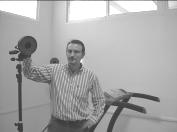|
Control motor humano y robótico– Motor control in humans and robots |


|
Arturo Forner-Cordero |



|
Brief CV Associate Professor at the Mechatronics Department Head of the Biomechatronics Lab. Also known as A. Forner-Cordero (erroneously cited as A F Cordero or A. Forner, because Spanish people keep the surnames of the father and the mother). Previous workplaces: Bioengineering Group IAI-CSIC. Katholieke Universiteit Leuven (Bélgica). Motor Control Laboratory of Stephan Swinnen Universiteit Twente (Países Bajos). Biomechanical Engineering. Instituto de Biomecánica de Valencia (España). MSc Electrical (Telecommunications) Engineering. Universidad Politecnica de Valencia.
Models of the human motor control system from a control engineering perspective KEY WORDS: Biomechanics and motor control. Motor system bioengineering. Biomechatronics. The main question guiding this research is: How does our nervous system plans, codes and controls motion? Research in motor control has been approached from different points of view: biology, medicine, psychology that, together with the mathematical and engineering methods led to important advances in this field. Nevertheless, current motor control models are limited in their ability to explain biological phenomena and in their cybernetic applications. The goal of this research is to discover some of the principles and define new models that describe movement control considering aspects such as the variability of biological motion and its hierarchical structure. It is expected to generate results which are useful for the clinician, as the models of motion control could help in the assessment of neuromuscular disease evolution and to apply the most effective therapy. In addition, unveiling some aspects of biological motor control would be very useful for the design of biomimetic systems in the field of control engineering and robotics. Finally, this work will contribute some basic research useful for the optimization of technical aids for elderly people and the disabled, growing populations with special needs in the European society. This research line contributed to the European Project ESBiRRo to develop a bipedal limit cycle walking robot with biomimetic recovery strategies. |
|
Escola Politécnica. Av. Prof. Mello Moraes, 2231 - Cidade Universitária 05508-030 - São Paulo-SP - Brasil Cidade Universitária. São Paulo. |
|
Tel:(+55) 11 3091 9968 |
|
Fax: (+55) 11 3091-5461 |